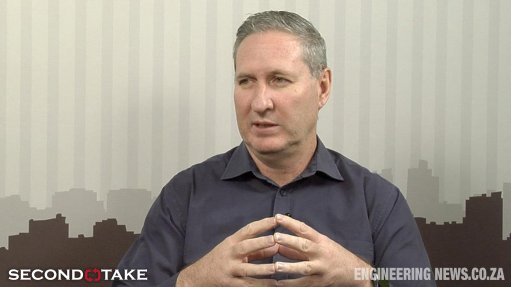New study points to 90% renewables mix being least cost by 2050


Enertrag corporate business development head Dr Tobias Bischof-Niemz
Photo by Duane Daws
New analysis conducted using updated cost assumptions for solar photovoltaic (PV), onshore wind and batteries shows that the share of renewable energy in an electricity mix that would also be the least cost for South Africa could grow to above 90% by 2050.
Such a portfolio, the study indicates, will be 30% cheaper than the generation mix currently outlined in the Draft Integrated Resource Plan (IRP) Base Case, published by the Department of Energy (DoE) in November 2016.
The analysis represents an update of the least-cost mix presented in March by the Council for Scientific and Industrial Research (CSIR) in response to the DoE’s call for public comment on the IRP Base Case.
In the March response document, the science council argued that the least-cost mix to meet a projected 2050 demand of 522 TWh would comprise more than 70% renewables, with the balance of the energy arising from coal, gas and hydro. Such a mix was calculated to be R75-billion a year cheaper than the one proposed in the Base Case and included no nuclear, which made up 28% in the Base Case.
In its submission, the CSIR made no significant adjustment to the assumptions used by the DoE other than eliminating what it described as the “artificial” restriction imposed on the yearly pace at which renewable energy could be introduced to the network.
‘REALISTIC’ ASSUMPTIONS
The updated analysis uses more “realistic” cost assumptions for the various supply-side options, based on the latest Bloomberg New Energy Finance technology-cost forecasts for solar PV, wind and batteries. The prediction is that solar PV costs will decline to R0.20/kWh by 2040, as opposed the R0.62/kWh bid in the most recent, but as yet not procured, bid window of the Renewable Energy Independent Power Producer Procurement Programme.
Likewise, the update assumes that wind costs will fall to R0.35/kWh by 2040, and battery costs are expected to decline from more than $400/kWh currently to $200/kWh by 2030, $150/kWh by 2040 and $100/kWh by 2050. Another newly introduced assumption is that South Africa will have a million electric vehicles (EVs) by 2030 and the EV fleet will grow to five-million by 2050.
By contrast the Draft IRP Base Case assumes only a marginal cost reduction in solar PV and wind by 2050, no further cost reductions for batteries and does not include any EVs.
Enertrag corporate business development head Dr Tobias Bischof-Niemz, who previously headed the CSIR Energy Centre, says the updated least-cost outcome raises the installed capacity of solar PV to 110 GW and wind to 100 GW by 2050. In the earlier IRP response document, the installed base was calculated at 74 GW and 85 GW for solar PV and wind respectively.
The two variable renewable-energy sources are backed and balanced in the updated model by 34 GW of mostly gas-based peaking capacity, 21 GW of lithium-ion batteries, 10 GW of residual coal, primarily arising from Medupi and Kusile, 7 GW of pumped hydro and 2 GW of hydro, as well as demand-response from both the provision of residential warm water, as well as from the newly introduced EV fleet.
The solar PV and wind generators emerge as the electricity “workhorses”, supplying the bulk (471 TWh/y) of the 531 TWh/y of primary electricity produced in 2050, while flexible generators supply just 60 TWh/y. Of that, the legacy coal plants, Medupi and Kusile, produce 37 TWh/y, gas-fired power stations 12 TWh/y and other renewables (hydro and biomass) produce 11 TWh/y.
As with the CSIR’s March 2017 submission, neither new coal, new nuclear, nor concentrated solar power (CSP) are part of the least-cost mix. However, should the cost of CSP production fall to R1/kWh, the cost optimal mix would then include 13 GW of CSP to produce 38 TWh/y of electricity. These CSP plants would mainly displace energy supplied by solar PV and wind, the installed base of which would fall to 100 GW and 89 GW respectively, and on the firm capacity side CSP would displace some batteries, pumped storage and some of the peaking plants.
Although there is 32 GW of peaking capacity, Bischof-Niemz notes that the actual energy from these plants, which are designed to respond rapidly to the variability of wind and solar PV, would represent only 2% of the overall energy. That means the amount of gas required, particularly with the introduction of batteries, would be extremely modest by 2050.
“In other words, with more realistic cost assumptions for solar PV, wind and batteries, the renewables energy share grows to above 90% by 2050,” Bischof-Niemz explains.
There would be a requirement for additional investments to provide system stability as synchronous coal-fired generators are retired and replaced by asynchronous renewables generation. However, even adopting a very conservative approach of adding synchronous machines, such as flywheels, would add only 0.7% to the overall cost of the system. And this only in the worst case, where a system operator in 2050 would have no other options available for system stability than today’s proven technologies.
Bischof-Niemz argues that such an expense would be more than manageable in a context where the least-cost, low-inertia system is a full 30% cheaper than the Base Case. The total system cost of the Draft IRP Base Case with realistic renewables costs applied is R670-billion a year by 2050, as opposed to R480-billion a year for the least-cost mix.
The yearly cost difference between a ‘business as usual’ mix, comprising new coal and new nuclear, and a renewables-based least-cost system would be an even more material R190-billion a year by 2050.
EVs IN THE MIX
Separate analysis conducted into the potential for “sector coupling” between power and transport shows that there could also be major economic and environmental advantages to incentivising the large-scale adoption of EVs in South Africa.
Besides the potential to decarbonise road transportation through coupling EVs to a renewables-led generation mix, there could be major foreign exchange and industrialisation benefits too.
Comparing the total cost of ownership of an internal combustion engine (ICE) car and an equivalent EV, which is able to travel 25 000 km/y over an average daily commute of 100 km, Bischof-Niemz calculates that EVs are already cheaper for such a car owner than a diesel or petrol alternative.
Assuming a fuel economy for the ICE of 8 l/100 km against the EV’s 15 kWh/100 km, he calculates a fuel consumption of 2 000 l/y for the ICE and 3 750 kWh/y for the EV. At R13/l and R2/kWh, the yearly fuel cost of the ICE is R26 000 as opposed to the EV’s R7 500. Should the EV cost R400 000 to buy against an ICE at R300 000, the yearly installments for the EV would be higher, at R65 000, against R49 000 for the ICE. However, maintenance on the EV will be lower, owing to fewer moving parts, at R15 000 a year, against R20 000 a year for the ICE. Therefore, Bischof-Niemz calculates the yearly total cost of ownership at R87 500 for the EV, as opposed to R95 000 for the ICE.
From a trade balance perspective, fuelling the EV with domestically produced electricity lowers the cash outflow to zero, as compared with $1 000 for an ICE with a fuel consumption of 2 000 l/y.
A million-vehicle-strong EV fleet would increase electricity demand by only 3.75 TWh/y, or 1.7%. However, this new demand could benefit Eskom in two ways. Firstly, it would increase electricity sales and, secondly, the utility could use the EV fleet to shift load into the low-peak periods, especially overnight, leading to higher loading of the coal fleet during these off-peak hours.
However, such a shift would definitely have industrial policy implications for a country that has made significant effort to sustain an automotive industry.
If South Africa did not move to manufacture EVs, the trade balance in the automotive sector would be negatively affected. However, should the Department of Trade and Industry (DTI) incentivise local EV manufacture and export, the trade-balance effects could be neutralised.
Trade and Industry Minister Dr Rob Davies has indicated that the DTI is keeping close tabs on the shift to EVs under way globally and what it could mean for the country’s automotive master plan, which is under review.
“Very definitely we have our eye on not finding ourselves in a position where we are the last outpost in the world manufacturing vehicles that the rest of the world has turned away from. We must be on top of the game.”
The DTI is determined to continue with an incentive programme to support the manufacture of automotive products into the future and notes that there is already an additional incentive for the manufacture of EVs. However, Davies acknowledges that local industry and government need have a deeper discussion around the implications of current moves to phase out the ICE in a number of countries.
“We can see there is an inexorable trend away from the ICE to other vehicle types. The kinds include fuel-cell vehicles, hybrids and EVs. We are already moving into the manufacture of fuel cells, so we shouldn’t forget that aspect of it as well.”
Comments
Press Office
Announcements
What's On
Subscribe to improve your user experience...
Option 1 (equivalent of R125 a month):
Receive a weekly copy of Creamer Media's Engineering News & Mining Weekly magazine
(print copy for those in South Africa and e-magazine for those outside of South Africa)
Receive daily email newsletters
Access to full search results
Access archive of magazine back copies
Access to Projects in Progress
Access to ONE Research Report of your choice in PDF format
Option 2 (equivalent of R375 a month):
All benefits from Option 1
PLUS
Access to Creamer Media's Research Channel Africa for ALL Research Reports, in PDF format, on various industrial and mining sectors
including Electricity; Water; Energy Transition; Hydrogen; Roads, Rail and Ports; Coal; Gold; Platinum; Battery Metals; etc.
Already a subscriber?
Forgotten your password?
Receive weekly copy of Creamer Media's Engineering News & Mining Weekly magazine (print copy for those in South Africa and e-magazine for those outside of South Africa)
➕
Recieve daily email newsletters
➕
Access to full search results
➕
Access archive of magazine back copies
➕
Access to Projects in Progress
➕
Access to ONE Research Report of your choice in PDF format
RESEARCH CHANNEL AFRICA
R4500 (equivalent of R375 a month)
SUBSCRIBEAll benefits from Option 1
➕
Access to Creamer Media's Research Channel Africa for ALL Research Reports on various industrial and mining sectors, in PDF format, including on:
Electricity
➕
Water
➕
Energy Transition
➕
Hydrogen
➕
Roads, Rail and Ports
➕
Coal
➕
Gold
➕
Platinum
➕
Battery Metals
➕
etc.
Receive all benefits from Option 1 or Option 2 delivered to numerous people at your company
➕
Multiple User names and Passwords for simultaneous log-ins
➕
Intranet integration access to all in your organisation



















